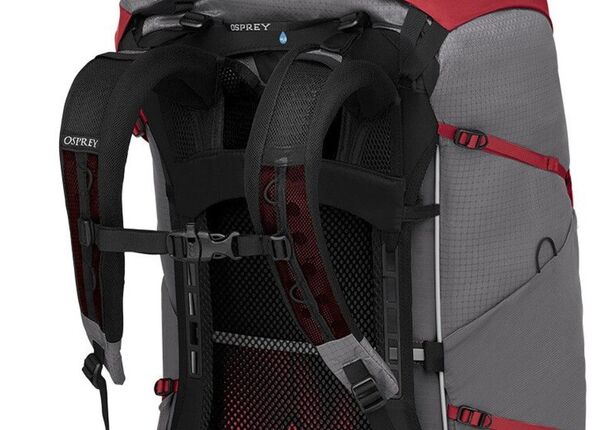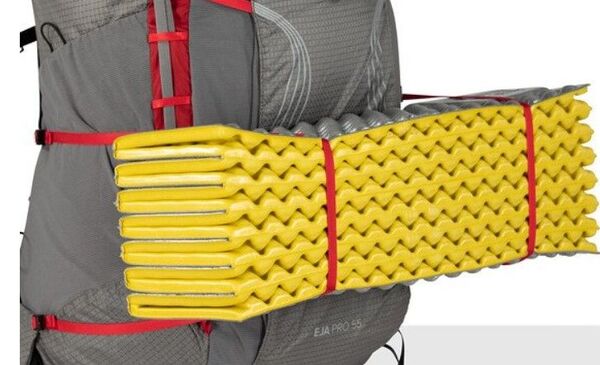There is a new series of Osprey Exos and Eja Pro packs on the market. So how different are they from standard Osprey Exos and Eja packs? Find out here.

Perhaps you know that Osprey has recently launched modified Exos and Eja packs and they are better than ever. I shall use the word ‘standard’ packs for them here in the text. It may be easier for you to check some of the features of these standard Exos and Eja packs if you check my text about the Exos 58 and Eja 48 packs.
But as you realize from the title, there is also now a Pro variant of these packs. These are new packs, and most of the pictures here in the text show these Pro packs. You can use the links above to compare them with the standard packs.
The most important common features (or absence of them)
I give here a list only of the most important features that are common for all these packs:
- Adjustable torso length: The design is slightly different but in both versions you have a ladder type torso length adjustability. Effectively they are the same.
- Removable lid: So you can remove the lid safely, and you still have an integrated FlapJacket that closes the pack.
- Single assess point from the top under the lid.
- Ventilated back panel: Both series provide excellent ventilation based on a trampoline style tensioned mesh. There is no principal difference here.
- There is no rain cover.
- There is no separate bottom compartment.
In this video you can see the Osprey Exos and Eja Pro packs:
The most important differences
I summarize the differences in the comparison table. Below the table, you can read more about the parameters and features used for comparison, and about my rating given in the table.
Variety of sizes
Attachments
Weight
Sternum strap
Straps
Pockets
Carry capacity
Price
Osprey
Exos & Eja Pro
Osprey
Exos & Eja
Variety of sizes: So the standard packs are built in three sizes for each gender, and then each of them has two sub-sizes. This means there are 12 packs in total. You can see them on the brand’s site.
In the case of Pro packs, there is only one Exos Pro and one Eja Pro packs, but each is in two sub-sizes (58 and 55 liters for Exos Pro, and 52 and 55 for Eja Pro). This means only 4 options in total.
Attachments: I give advantage here to the standard Osprey Exos and Eja mainly because they come with the Stove-on-Go attachment system for trekking poles. You do not have this in the Osprey Exos and Eja Pro packs.
In the Osprey Exos and Eja packs, attachment loops on the bottom are paired with bungies on the front. The bungies are absent in the Pro series, you have to use upper side straps if you want to keep an ice axe attached to those bottom loops.
However, note that the Osprey Exos and Eja Pro packs have a series of webbing loops on the front (see the picture) that are not present in the standard Osprey Exos and Eja packs.

Weight: No doubt this is the most important difference, and it is easy to compare.
- So take the Osprey Exos 58 liters from the standard series, this is the S/M subsize. It weighs 2 lb 13 oz (1.28 kg). So this is indeed an ultralight backpack, its volume to weight ratio is 45 liters/kg.
- Now compare this with the Osprey Exos Pro 58, this is the L/XL sub-size. It weighs 2.165 lb (0.98 kg). So it is 30% lighter than the standard pack mentioned above, and its volume to weight ratio is incredible 59 liters/kg. You could call it super-ultralight.
Sternum strap: The sternum strap is adjustable on both versions, but in the Pro packs it is with a ladder type adjustability, see the picture below. The standard packs have a sliding sternum strap.
The latter is easier to use, but the ladder type is more reliable, and you can use those webbing loops to attach some other things as well. So the Pro packs’ sternum strap is better.

Side straps: I find the side straps in the Osprey Exos & Eja Pro packs a bit more functional. Here you have separate upper and lower side compression straps.
The lower straps on both sides can be removed. These straps can also be used to attach a sleeping pad on the bottom, see the picture. But note that there are no separate bottom straps on the Pro packs.

On the other hand, in the Osprey Exos & Eja packs there is a single and removable side strap on each side. It goes all the way up and you can cinch it from the top and from the bottom.
I do prefer two separate straps, but note also that the standard Osprey Exos & Eja packs have dual removable bottom straps as well. So all in all, I give advantage here to the standard packs.
Pockets: The hip belt pockets in the standard Osprey Exos & Eja packs are both with zippers. In the Osprey Exos & Eja Pro packs, only one has a zipper.
Also, the front pocket in the standard pack is better designed, it has a strap and buckle on the top. You can see the difference in the top pictures above.
Carry capacity: The carry capacity of the standard packs is 30-35 pounds (14-16 kg). In the Pro packs this is 10-30 pounds (4.5-14 kg). I am not completely sure about the true meaning of the lower limit, but this is what they officially give.
However, it is obvious that the standard packs are suitable for more weight, and this is visible when you compare padding on the shoulder harness and the hip belt.
Note also that the LightWire peripheral frame in the Pro packs is 3.5 mm diameter, and it is 4 mm in the standard packs. The fabric in the standard packs is a 100D and 400D high tenacity nylon, while it is 100D and 200D UHMWPE ripstop in the Pro packs. This all is partly behind the weight differences discussed above.
Price: As of the moment of writing this text, the Pro packs are more expensive. Frankly, I do not see any reason for this.
Conclusion
So to summarize, from the comparison table and the discussion presented above, it follows that the Osprey Exos and Eja Pro packs are inferior to the standard Osprey Exos and Eja packs.
But the weight difference is indeed far from negligible and this is the most important difference. This Pro series is incredibly light and it still has plenty of great features that come with the Exos and Eja series of Osprey.
All these packs are available at the site of Osprey, you have them side by side and it is easy to compare and to check current prices. You will find them also at REI.
Let me know what you think, there is a comment box below. You might want to check also my comparison text about their new Osprey Atmos & Aura AG LT backpacks and about Osprey Talon & Tempest Velocity Packs.
Bookmark this site and come again, you will always find new texts of this type here. Thank you for reading and have a nice day.
Mieke says
I would love it if Osprey would also produce a Eja Pro pack in smaller sizes, ie for example around the 40 l.
I hike/trek ( 750 to 1000 km ) with an Osprey Women’s 37 l pack which weighs around 1.5 kg. If only that would exist in a Eja Pro 40 l version that’d be great.
Jovo says
I assume this is about weight/features combination and this is hard to match. But consider Sierra Designs Flex Trail 40-60 Backpack, it is remarkably light and expandable. Also have a look at Deuter Ultra packs.
By the way, I am impressed that you manage with such a small pack.